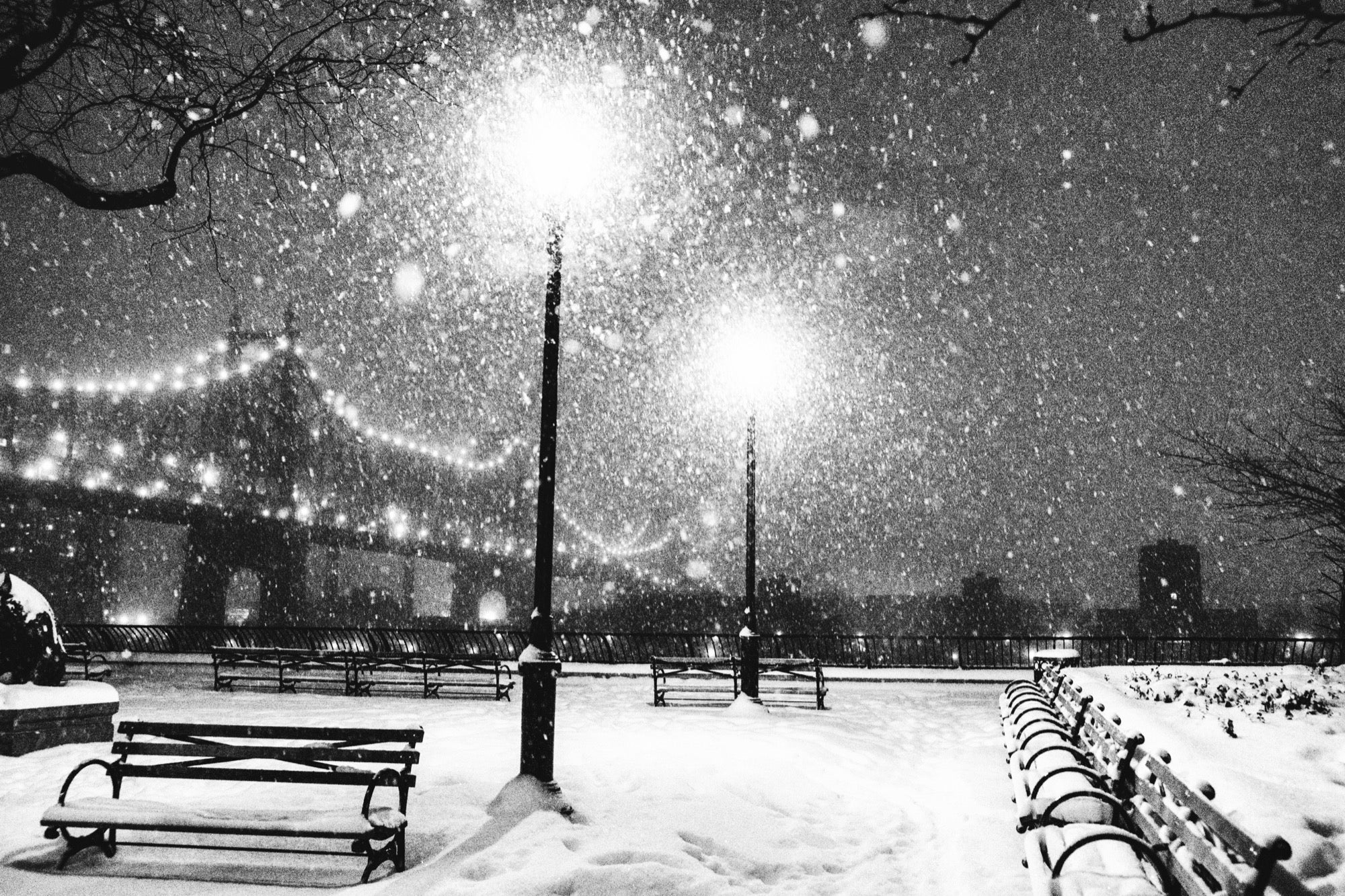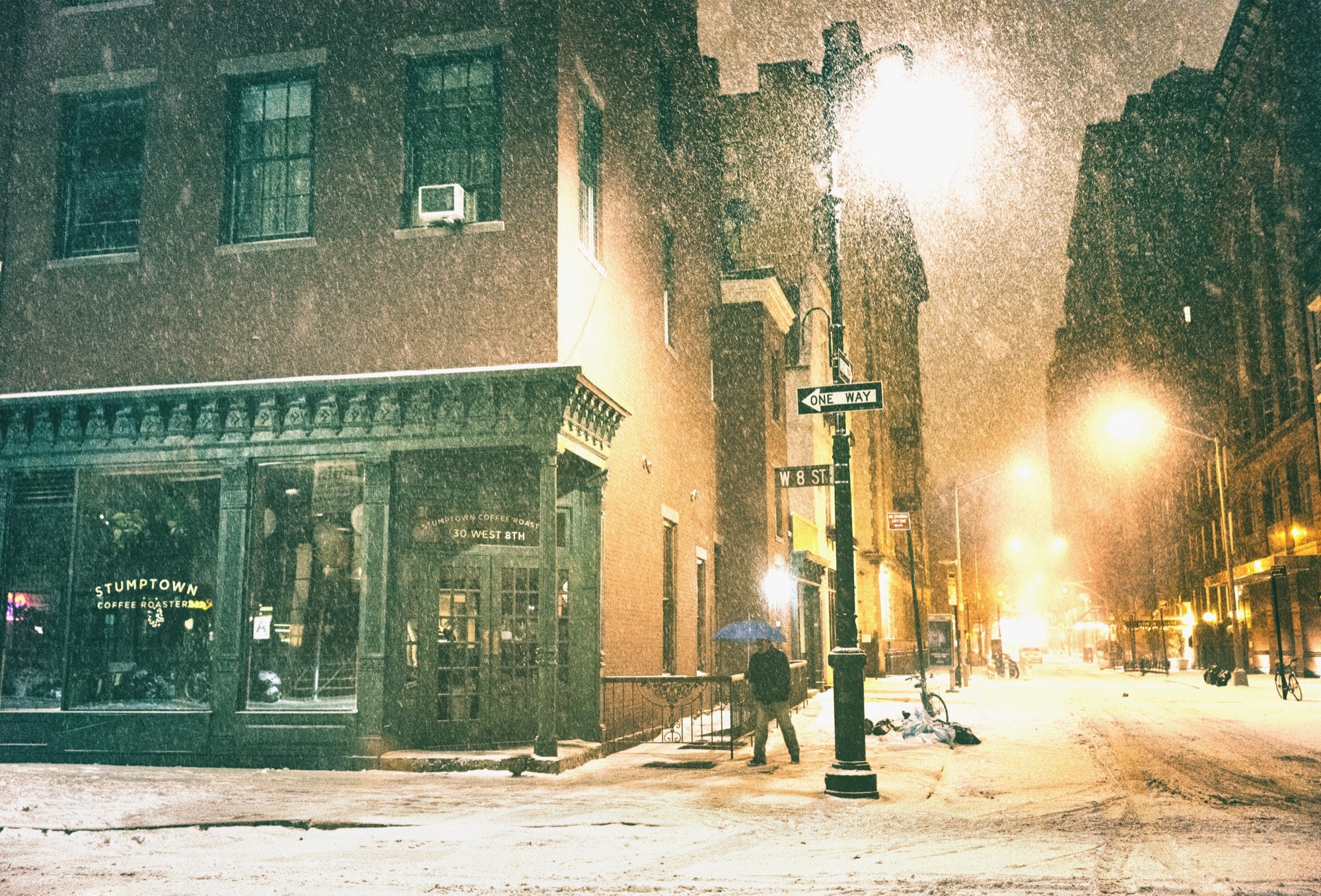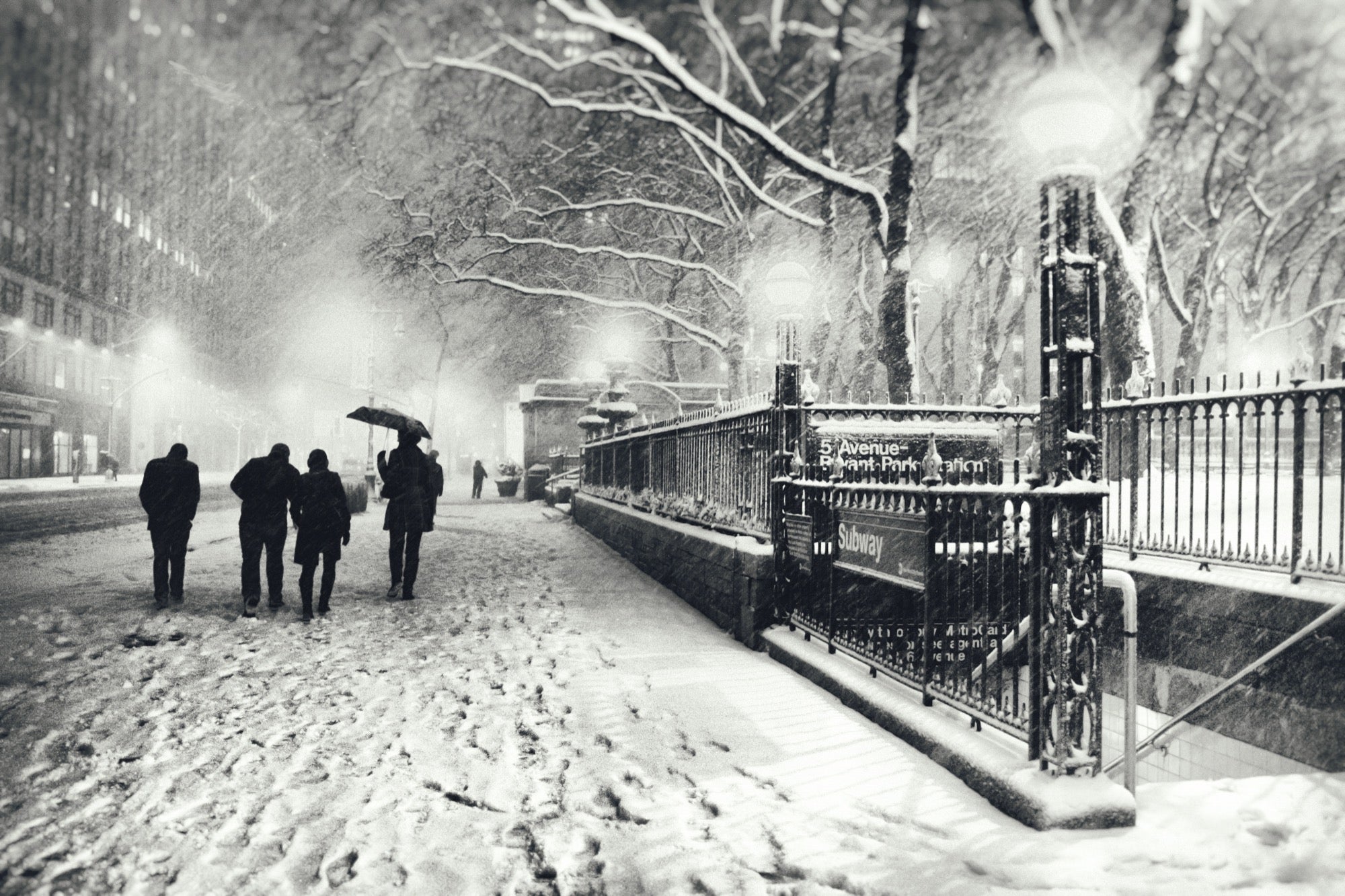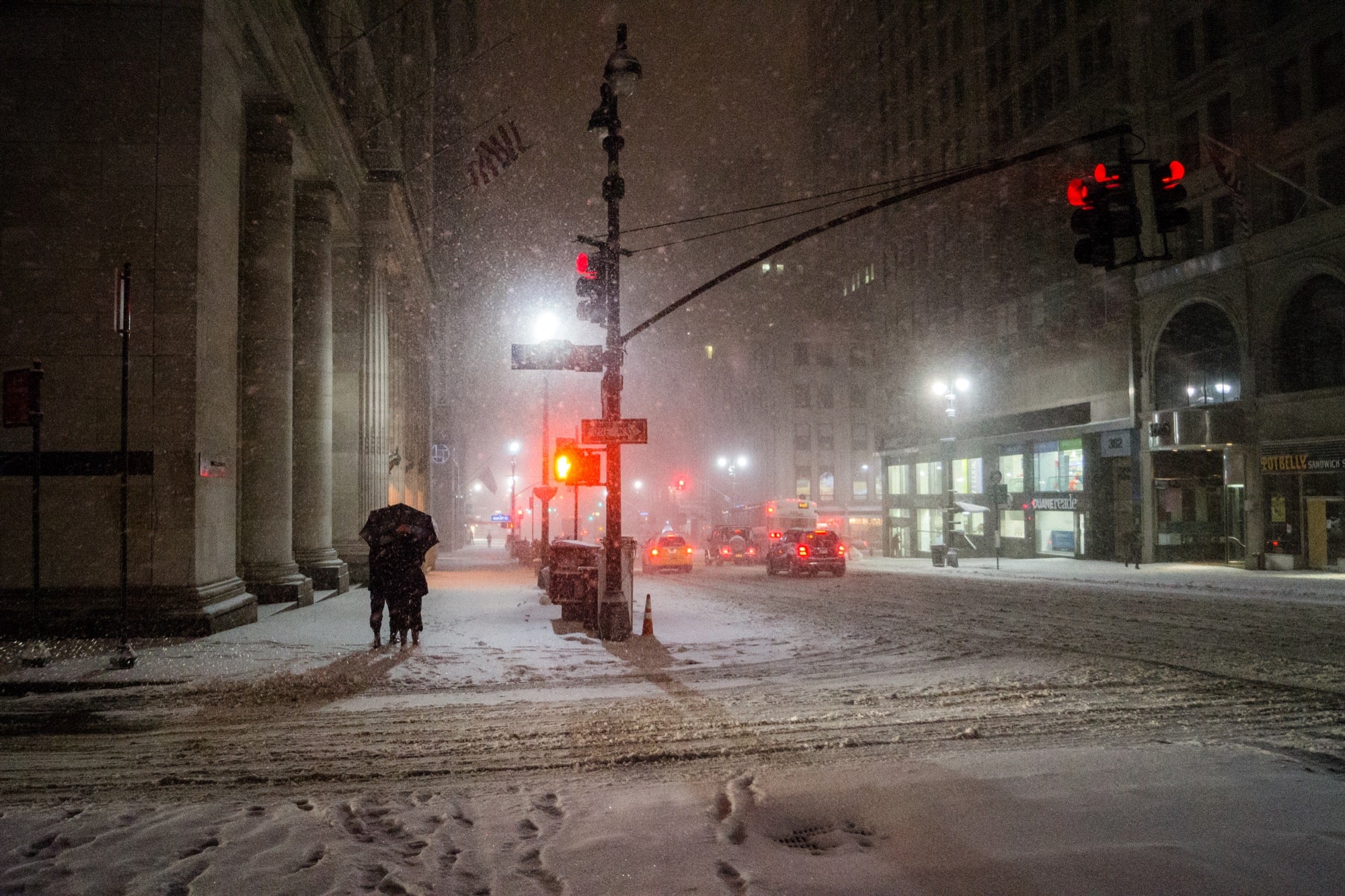Sony Artisan Vivienne Gucwa has spent much of her young career making images of New York City. Though much of it is strikingly beautiful, her photographs are far from picture postcards of a beloved city. Instead, New York is the canvas on which she expresses intensely personal sentiments. Her work deals with themes of loneliness, loss and isolation and in her brand new book, "New York in the Snow," Gucwa tells her most personal story yet.
Alpha Universe: Your first book, "New York Through The Lens," was released three years ago. This one focuses on New York in one particular kind of weather, but I’m guessing that’s not the only difference.
Vivienne Gucwa: "New York in the Snow" is my passion project. It has the most meaning to me out of anything that I’ve ever shot of New York. I started photographing snow the very first winter that I had a camera. When I was growing up here in New York, we did get quite a bit of snow in the winter and it was the one time for me that it would level the economic playing field. I have very distinct memories of a blizzard when I was younger and going out on a neighbor’s sled and being pulled through the streets and looking at the snow through the street lights and thinking everyone is having the same experience, no matter who they are.
It doesn’t matter what’s going on in your life. In the snow we’re all looking at the same snowflakes under the same light. And it’s that beautiful feeling that I kept with me as an adult.
It became a thing that I went back to that was my escape. I would go back to those feelings of nostalgia, and wonder which were all the things that snow, for me, embodied. So when I photographed my first snowstorm it was a huge deal for me.
Going out into the first snowstorm, in the middle of it I realized ‘Oh my god, I’m capturing this thing that I’ve been thinking about for years. And I’m finally finding a way to share this moment in some way.’ Then it just became this thing I had to do. Every single snowstorm that we had, I would go out and photograph it. And I think it also evolved with how I thought a lot about photography and why I take photos and the themes that I’m attracted to; themes like time and mortality; I’m very appalled and mesmerized by the concepts of time and mortality.
Alpha Universe: Appalled?
Vivienne Gucwa: Time and mortality are both embodiments of ephemerality. I think about how ephemeral snow is. It's a metaphor for our lives as bleak as that sounds. I think that as I took photos in snowstorms I developed the idea of what I was actually thinking about when photographing snow. I really focused on how it feels to be alone in a city as big as New York City, specifically how it feels to be one of several million people while feeling completely isolated and dealing with loneliness and anxiety. Snow magnifies all these feelings that go along with urban living especially how at night when it snows here, all the streets tend to be empty. Trying to capture that feeling of being in such a large city and still feeling alone became a sub-theme of all of my snow photos.

Sony α99. Sony 24-70mm f/2.8 ZA lens. 1/20-sec., f/3.2, ISO 4000. The trees near Bryant Park always remind me of Narnia from The Lion, The Witch and The Wardrobe when they are laden with snow. I grew up with that book and loved imagining having a wardrobe of my own to walk into that would open up to a world of snow. Walking through snowstorms with a camera in hand lets me live in my own Narnia over and over again.
Alpha Universe: Is it frustrating for you if viewers don’t look for the context?
Vivienne Gucwa: I think that’s always a bit of a frustration. Because, especially now, I think we’re in an age where photography is so ubiquitous and it’s become part of what we all do with our phones. I think for a lot of people who view photos, because there’s so much content out there now, it’s very easy to think, ‘oh, you know these people are just taking a photo of whatever it is: a landscape, snow, a building’.
For me it’s always been about more than just that. Of course I’m into the beauty of it, the ugliness of it, the sadness of some of the things that I photograph in the snow, but the most I can do is write out the context, which I think is important.
I’ve never really been one of those people who says a picture is worth a thousand words and you shouldn’t need to write about it. I think that context and influence and all the things that go into life and inform what you do as an artist actually matter when it comes to the end product. The most I can do is write and hope maybe people read what I write. At the same time, it’s also super fascinating to see that there is a certain universality to what people enjoy out of this content, what they don’t enjoy, and what people gravitate towards.
Something else I’ve been interested in with all my photos of New York is nostalgia. Like longing for a place you’ve never been to. Why do we sometimes have those feelings? Or why do certain colors used in photos, or certain compositions, make people feel that way? And I think the snow photography for me has been the most powerful vehicle for exploring that, versus maybe a lot of the other work I’ve done in New York.
I think what’s interesting is seeing how certain photos touch a nerve in people no matter where they are in the world or what their circumstances are. There seems to be certain photos that evoke a certain response even if people aren’t reading the context that I’m trying to share with the photo. That’s been really fascinating.

Sony α7 II. Sony 16-35mm f/4 lens. 1/80-sec., f.2.8, ISO 4000. There was a blizzard on the night I took this photo. I very specifically crawled through the snow drifts to take this photo which is an homage to a movie poster I grew up looking at (Woody Allen's Manhattan). The drifts were so deep on this night that I couldn't find the stairs that led up to this spot located at Sutton Place in Midtown Manhattan.
Alpha Universe: Is there a particular snow photo that’s been shared more than most?
Vivienne Gucwa: One of the most viral photos I’ve ever taken and the one that’s always the clear favorite is one that I took on 9th Street in the East Village. I specifically waited a few hours in the snow for a certain person to walk into the scene. I thought obviously the street is beautiful, but there’s a lot of sadness in the photo.
It’s a very interesting photo too, because right after I posted it a family contacted me and they said ‘I don’t know if you know this, you obviously don’t know us, but the sign in the photo, C’est Magnifique, that’s my brother’s store and he passed away tonight. And you took this photo and I just saw it posted online.’ It was a really big deal for the family and it was really interesting to me because I remember taking the photo and feeling like I expressed this sort of sadness that I feel living in New York and dealing with all the things I’ve dealt with in my life. It’s ironic because maybe 99% of all the people who love the photo say ‘this is the most beautiful photo, I love it! It shows pure beauty.’ Yet, there are so many other layers to it, which is true for pretty much most writing and art and everything I suppose.

Sony α99. Sony 24-70mm f/2.8 ZA lens. 1/100-sec., f/3.2, ISO 4000. I remember specifically walking to this street to capture this scene on this night. This scene tells a story I felt compelled to tell, and evokes everything I try to capture with my snow photography. I waited two hours for the right person to walk into the scene and the signs were as much a part of the story as the lights. When I was younger, this is how the East Village looked in my imagination when I would think about it late at night before drifting off to sleep.
Alpha Universe: You said you waited for a specific person to enter the scene?
Vivienne Gucwa: In all of my shots in the snow, they’re all candid, but I usually wait for someone to come into the frame. I have no clue who the people are in most of my photos.
For example that particular photo, I knew the framing that I wanted and I knew what I wanted it to look like in my head, because that’s how I envisioned the street when I was little, because it’s one of my favorite streets. To tell the story of the sadness and loneliness, I really needed a lone figure to walk down the street. So I waited for the right kind of figure. In another photo it might be someone with an umbrella or some other thing. I’ve waited up to three hours in blizzards for just the right person to come along. I was in a blizzard once and there were 60 mph winds, and I was thinking ‘why is nobody coming by?’
Alpha Universe: What did you use as far as cameras and lenses for this project?
Vivienne Gucwa: I mainly used Sony cameras the whole time. My first real camera was a Sony. And then I went through a ton of other Sony cameras over the years. They have been the tools that let me do everything that I’ve done, and explore all of these themes and grow as an artist. I think that’s a huge part of it.
My cameras have varied by year. I would say the majority of photos in the book were taken with the α99. I had the α99 for a solid two years, which is a long time in terms of snowstorms. I shot a lot of the major snowstorms with that camera. It’s so good. Now I’m using the α7R II.

Sony α99. Sony 24-70mm f/2.8 ZA lens. 1/20-sec., f/3.2, ISO 4000. There are certain streets that are dripping with nostalgia and longing. This street in Greenwich Village is one of those streets. The lights glow and diffuse the blowing, falling snow during snowstorms. I often spend a lot of time waiting for the right character to walk into a scene. I consider all the locations I photograph scenes and the people who candidly walk into them are the actors who complete the scene and tell the story.
I’m very minimalist when it comes to gear. It started out as a practical thing because when you’re out for a number of hours in blowing snow and wind, it’s painful and you’re thinking, ‘oh, I don’t want my camera to stop functioning because I’m going to change my lens.’ I think the practicality of having one lens that does the job and having a camera that will last through those conditions has been a big thing for me.
And it’s also, weirdly enough, the reason why, when I went to the Arctic last year, I took literally one Sony camera and one Sony lens. It was a 24-70mm with the Sony α7R II. For me it’s about not thinking about the gear because you’re confident that the gear can work. I want the gear to just do the thing. I want to blink my eye and have things happen.
I joke all the time with Sony that for the last three years my dream was just to have a camera in my eye. Which I know is a lot of people’s nightmares. For me, I don’t want to think about the gear when I’m actually out there shooting. I want the gear to be so good that I’m not thinking about it ever. That’s how I got through all the snowstorms using a minimal set-up.
I think what speaks volumes when it comes to gear is what you do with the gear. It’s ultimately all down to what you create.

Sony α7R II. Sony 16-35mm f/4 lens. 1/20-sec., f/3.2, ISO 4000. Snow creates its own suspended reality in New York City. In this moment during a blizzard, snow was rushing through the street at around 60 mph and the gusts were so strong and painful that people were stopped in their tracks and had to turn sideways to not feel the extreme gusts at full force.
Alpha Universe: Was there a particular lens you favor for photographing New York in snow?
Vivienne Gucwa: I obviously shoot wide a lot, because for me shooting wide tells more of the story of the surroundings and the person in the shot. Or if there’s no one in the shot that tells a whole different story. For a while I was shooting with the 16-35mm because my favorite focal length to shoot at is 18mm or 20mm. At the same time I love the 24-70mm lens. I shoot wide, but it also lets me sort of get in closer if I need to. I don’t tend to do that often, so for me the 24-70mm range covers pretty much everything I want.

Sony α99. Sony 24-70mm f/2.8 ZA lens. 1/125-sec., f/3.2, ISO 4000. This was originally a rejected photo from this particular storm. I typically come home after walking around seven miles in a storm and immediately go through my images and edit my favorite 10 images from that storm. Since this one didn't make the cut, I didn't even discover it until months later when I was looking through the images of that storm for a client. I distinctly remembered standing there for hours waiting for the right combo of people to walk by me. I was ready to leave the area and this group walked past me and it was perfection.
Alpha Universe: Do you feel compelled to work fast when you’re out in the cold?
Vivienne Gucwa: I think shooting in snowstorms really helped me slow down in terms of the amount of photos that I take. When I’ve given presentations about snow shooting people assume I take thousands of photos during one snowstorm but the reality is when I photograph snowstorms the last thing I want to do is come home and go through 2,000 shots of similar things over and over and over again.
It actually forced me into more of a film shooter mindset. Even though I’ve never shot film, I imagine that’s what it’s like; you imagine every shot that you’re taking because every shot costs money. And you don’t have that many frames in a roll with film, so you don’t have the option of shooting thousands of photos. For me it definitely changed how I shoot in general, which has been a really fun process.
Alpha Universe: Is post-processing an important part of your work?
Vivienne Gucwa: Oh yeah, it’s probably the biggest part. Composition for me is obviously a huge part of everything. It’s the first part of what tells the story about what you’re photographing. Whereas I feel like post processing is how I convey the mood, the themes and how I shape the context of what it is that I’m trying to convey. So, yeah, post-processing is a really big deal. Primarily I’m a Lightroom user. I almost never use Photoshop unless it’s for a specific job where I need to use one specific tool.

Sony α7II. Sony 16-35mm f/4 lens. 1/20-sec., f/5, ISO 4000. This photo was taken late at night on a night when all cars, taxis, and buses were banned from the streets. It was almost impossible not to capture this moment as a person walked home from work down the middle of a street that is usually full of traffic.
Alpha Universe: What’s your process like when you’re out there in the cold and snow?
Vivienne Gucwa: It’s kind of this weird… I don’t like calling it this, but the best way to describe it that I can think of is it’s like a vision quest every time it snows. Because I know that I’m going to go out, I know I’m going to be out for a number of hours, and it’s pretty grueling. I typically walk anywhere from seven to eight miles in a snowstorm. I’ll walk from my neighborhood in the Lower East Side to different parts of the city. In one snowstorm we they had shut down the subways completely. There were no cabs. For that one I walked eight or nine miles, because I really wanted to capture the feeling of the Upper East Side and Upper West Side, which is kind of insane in scope, geographically speaking. I really didn’t think about it before I went out. Also, because I’m shooting outside and there are so many issues with cold and condensation, I don’t really have the luxury of being able to dip into places and warm up. I have to figure out not only how to protect myself in these conditions but how not to overheat, how to not get too sweaty and risk hypothermia.
If you go into a place where there’s a drastic change in temperature, then you deal with the camera fogging up, the sensor fogging up and other issues like that. So once I’m out, I’m out. I’m committed. There’s something about that for me that turned into this weird vision quest type of thing.
There’s a physicality to this that a lot of people don’t realize. I’ve discussed the physicality, but to some extent that takes away from the magic of it. Both from an artistic level, having to explain it, but also because I think when people experience really good writing, art or cinema, there’s something about not understanding how things are done. When you see an amazing movie it’s so much more magical to just be lost in it and not think, ‘wow, I wonder how many shots it took? Is this one continuous shot? What was the deal with that?’ I like the magic.
Vivienne Gucwa is a Sony Artisan of Imagery. See more of her work on her website and follow her on Instagram @travelinglens.

Sony α99. Sony 24-70mm f/2.8 ZA lens. 1/80-sec., f/3.5, ISO 4000. I have shot snowstorms in New York City for the last 6 years. When I first started taking photos in snowstorms it was mainly to capture the wonder of experiencing snowfall in a huge city. The streets tend to empty out and what's left is endless sidewalks and streets to walk on. The more I photographed them the more I realized that I was trying to convey the loneliness and isolation of being surrounded by millions of people. I often photograph lone candid figures or couples in the snow to convey the vastness of the city and these emotions.

Sony α99. Sony 24-70mm f/4 lens. 1/1215-sec., f/4, ISO 4000. It was a particularly harsh storm that night. The snow was heavy and the wind was whipping through the streets at around 55 mph. I turned my back to the wind as the eerie silence of the city engulfed me with an existential vastness that made me feel both small and invincible at once. Something in me made me turn around with my face to the wind and snow, just for that moment. And in that moment, a couple stopped on the next corner to embrace in the wind under the shelter of an umbrella for mere seconds. Maybe they were feeling the same way I was. Maybe we were connected in that moment by the wind rushing into our souls, or by the snow falling from the sky like star matter; glittery white remnants of others who came before us.



